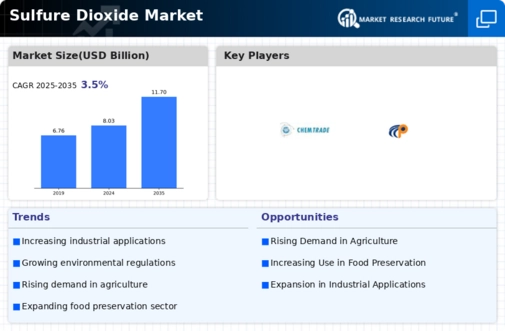Market Analysis
In-depth Analysis of Sulfur Dioxide Market Industry Landscape
The sulfur dioxide market experiences dynamic shifts influenced by various factors impacting both its supply and demand. Sulfur dioxide, a chemical compound consisting of sulfur and oxygen, finds application in several industries, including food preservation, water treatment, chemical manufacturing, and the production of sulfuric acid. The dynamics of this market are shaped by factors such as industrial activities, regulatory policies, environmental concerns, technological advancements, and economic conditions.
One of the primary drivers of the sulfur dioxide market is its widespread use as a preservative in the food and beverage industry. Sulfur dioxide is commonly utilized to prevent microbial growth, oxidation, and spoilage in a variety of food products, including dried fruits, wines, and canned goods. The demand for sulfur dioxide in the food industry is influenced by factors such as consumer preferences for extended shelf life, food safety regulations, and the need to minimize food waste. Additionally, the growing popularity of organic and natural food products has led to increased demand for alternative preservatives, impacting the overall dynamics of the sulfur dioxide market.
The sulfur dioxide market is also influenced by regulatory policies aimed at reducing air pollution and mitigating environmental impact. Sulfur dioxide is a byproduct of industrial processes such as fossil fuel combustion, metal smelting, and chemical manufacturing, contributing to air pollution and acid rain formation. Regulatory agencies impose stringent emission standards and pollution control measures to limit sulfur dioxide emissions from industrial sources, requiring companies to invest in pollution abatement technologies and sulfur dioxide scrubbing systems. Moreover, regulations governing the use of sulfur dioxide in food preservation and water treatment aim to ensure product safety and protect public health.
Technological advancements play a significant role in shaping the dynamics of the sulfur dioxide market. Continuous innovation in sulfur dioxide production methods, purification techniques, and emission control technologies has led to the development of more efficient, cost-effective, and environmentally friendly solutions. For example, the introduction of sulfur dioxide recovery and recycling technologies enables companies to recover sulfur dioxide from industrial emissions and reuse it in manufacturing processes, reducing waste and environmental impact. Similarly, advancements in sulfur dioxide scrubbing systems and flue gas desulfurization technologies help industries comply with emission regulations and minimize air pollution.
Market dynamics in the sulfur dioxide industry are also influenced by economic conditions and industrial trends. Fluctuations in energy prices, raw material costs, and industrial output can impact the cost of sulfur dioxide production and distribution, affecting market competitiveness and profitability. Moreover, changes in consumer preferences and purchasing behavior, such as increased demand for environmentally friendly products and sustainable practices, drive innovation and market differentiation within the sulfur dioxide industry.


 End-Use Industry: Secondary Research, Primary Research, MRFR Database and Analyst Review
End-Use Industry: Secondary Research, Primary Research, MRFR Database and Analyst Review


Leave a Comment